
|
Sale 68
The June 30th Manuscript and Collectibles Auction
| Lot |
Photo |
Description |
Realized |
Lot 92 |
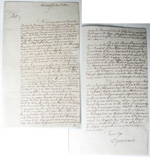 |
1763 Order to Enforce Tax Collection in the American Colonies. Manuscript Letter Signed ("Egremont"), 3pp, Whitehall, July 9, 1763. As Secretary of State for the Southern Department, Sir Charles Wyndham, second Earl of Egremont (1710-1763),was the minister responsible for America. To an unidentified correspondent, possibly written as a circular letter to each of the colonial governors in America, or possibly to Thomas Gage, who was commander-in-chief of British forces in North America from 1763-1775. In part:
"Sir It having appeared that the Publick Revenue has been greatly diminished and the Fair Trader much prejudiced by the fraudulent Methods used to intoduce into his Majesty's Dominions contrary to [he names two acts from Charles II and one from William III] for preventing Frauds and regulating abuses in the Plantation Trade…by means of small Vessels hovering on the Coasts; And that this iniquitous practice has been carried to a great Height in America; An Act was passed the last Session of Parliament, intitled, An Act for the further Improvement of his Majesty's Revenue of Customs; and for the Encouragement of Officers making Seizures, and for the Prevention of the Clandestine Running of Goods into any part of his Majesty's Dominions….The Commander of His Majesty's Ships stationed in America will in consequence thereof, be vested, for the future, with the necessary and legal Power from the Commissioners of the Customs for carrying into Execution the several Acts of Parliament relative to the Seizing and condemning any Ships that Shall be found transgressing against the said Acts…." Egremont blames America for Britain's debt: "…this Nation is Labouring under a heavy Debt incurred the Last War for the protection of America…." and insists on "implicit Obedience" to the King's commands…in a Matter on which his Majesty lays so much Stress…." Some professional repairs. Boldly penned and signed.
In order to finance the Seven Years' War, the government had borrowed money from the Dutch, merchant bankers, the Bank of England, private companies and individuals, at high rates of interest. In order to pay off these debts, George Grenville introduced new forms of taxation in America. In 1764 the Sugar Act was passed. When the Sugar Act did not raise as much revenue as had been expected, the Stamp Act was passed in March 1765, resulting in riots throughout the American colonies, and culminating in the Stamp Act Congress. "No taxation without representation" became the cry, and so it began.
Estimated Value $2,000 - 3,000.
View details and enlarged photos
| Realized
$2,100 |
Lot 93 |
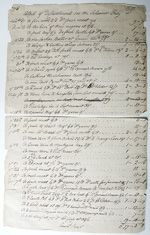 |
1775 Bill of Disbursement on the Schooner Polly. Manuscript document signed by John Buffinton, one page, 12½ x 8 in., n.p., 1775. The list includes food and supplies taken on in Jamaica, including lots of meat, wood, oil, nails, etc. Expenses also included caulking for the ship, horse hire from Port Morant to Kingston and to Pell River, canoe hire to Montegue Bay, and "To the hire of three negroes at 2/6." Document is cleanly separated at horizontal fold; edge chips affect a couple of numbers.
Estimated Value $400 - 600.
View details and enlarged photos
| Unsold |
Lot 94 |
 |
1776 Certificate Regarding the Ship Alfred. Manuscript document unsigned, 3 x 7½ in. Philadelphia, Aug. 13, 1776. Certifying that John Ouldam "Enter'd on board the Ship Alfred as Ship's Barber and I understood him to be a Servant to Mr. Wm. Hardy of Philadelphia." On April 6, 1776, the 30-gun Alfred was part of an American fleet returning from a raid on Nassau when it encountered the British sloop H.M.S. Glasgow off Block Island, Rhode Island and was badly damaged, along with several other American ships--a poor showing for the fledgling American Navy. A rare document regarding one of the first ships in the American Navy.
Estimated Value $1,200 - 1,500.
View details and enlarged photo
| Unsold |
Lot 95 |
 |
1776 List of Arms Issued to Soldiers. Revolutionary War-date manuscript document, one page, 12½ x 7¾ in., n.p., Sept. 10, 1776. Headed "Guns Apprisd in Capt. John Perkins Compy." Listing the names of 31 officers and soldiers and the various items issued to them, including guns, bayonets, cartouches, straps, boxes, etc. The cost of each soldier's equipment is noted by his name. Fine. Lightly affixed at top edge to 14½ x 9¾ mat.
Estimated Value $1,200 - 1,500.
View details and enlarged photo
| Unsold |
Lot 96 |
 |
1776-1777 "The State Cloathing Acct" For New Jersey. Manuscript Document signed by John Cleves Symmes, one page, 8 x 12¾ in. A statement of expenses incurred and monies received for clothing and bedding the troops. The Dec. 1, 1776 through Jan. 16, 1777 listings show monies received. The Jan. 18 through June 27, 1777 listings are for expenses incurred and not yet received. One listing is for "12 sheets put into the Hospital at Springfield." Very good; paper is toned with a few edge chips. Clear bold writing.
John Cleves Symmes (1742-1814) was Chairman of the Sussex County Committee of Safety in 1774, and was elected to the New Jersey Legislative Council in 1776. He was Colonel in the 3rd Battalion, Sussex Militia (1777-1780), Associate Justice of the Supreme Court of New Jersey (1777-78), and served in the Continental Congress (1785-86). His daughter Anna Tuthill Symnes (1765-1864) married future President William Henry Harrison.
Estimated Value $500 - 600.
View details and enlarged photo
| Unsold |
Lot 97 |
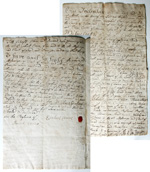 |
1778 New Jersey Indenture. Revolutionary War-date Manuscript Document Signed by Ezekiel Crane, 1½pp, Newark, Essex County, New Jersey, April 23, 1778. Document by which Ezekiel Crane sells a tract of land in Elizabeth Town to Elias Crane for eighty-five pounds. Witnessed by Joseph Crane. Red wax seal by Ezekiel Crane's signature. Toning and soiling, else very good.
Estimated Value $250 - 350.
View details and enlarged photos
| Unsold |
Lot 98 |
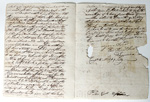 |
1779 Revolutionary War Letter With Speculation on Spain's Aid. Autograph Letter Signed "D. Lyman,"3½pp, 9½ x 7½ in., Roxbury, Mar. 7, 1779. To Peter Colt, Hartford west Division. "…It was believed here that the Army had marched as far as Milford on the Sea Coast from New York….The enemy are playing a very advantageous game since the reduction of the little State of Georgia. Few accounts have arrived from the Southward. We suppose they are securing their conquests and taking all possible advantage of their plunder which will consist principally in such articles as are wanted for their Army at new York. The Army at Newport seem to be progressing very little….We most impatiently wait for the particulars of the Spanish vessel. General Hancock received a letter from a member of Congress which informed him that news was received from Spain which would excede his most sanguine expectations so we conclude nothing less than a treaty is concluded if so farewell to the war. Then you will have nothing to do but enjoy domestic life….Whilst poor me will be obliged to seek a fortune without the means of procuring one & with no other consolation than the reflection that thousands are no better off than myself--who would not serve his country. Paper money seems now to be reduced almost to nothing. 12 paper dollars are now given for a silver one….Some imagine Congress are playing a politic game and determine to take the advantage of a loan from Spain of several million dollars to reduce the quantity of the paper currency at this low value. I think no bad scheme. We shall be on to join the Army when the campaign opens which I hope wont be long…." Ink bleed-through makes reading difficult but very boldly written and signed. Tape repair on page 3, numerous small pinholes and seal tears. Hand-written transcript included. Interesting content.
Spain had been on the losing end of the Seven Years War (French and Indian War in North America), and harbored enmity toward Great Britain. To this end, Spain was already covertly helping the Americans, but openly joined in the fight after signing the Treaty of Aranjuez with France on April 12, 1779 (just over a month after this letter was written) which specified as part of the terms that Spain should join the French in supporting the American colonies against Great Britain.
Estimated Value $750 - 850.
View details and enlarged photo
| Realized
$750 |
Lot 99 |
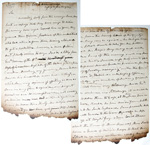 |
1781 Letter From Camp Williamsburg Regarding British Troops. Partial Autograph Letter unsigned, 2pp, 11½ x 7 ½ in., Camp Williamsburg East of Taylors Ferry, May, n.y. [7, 1781 is penciled in]. From Jethro Sumner (1733-1785), who had served as a Col, 3rd Regt., North Carolina Militia and in 1779 was appointed Brig. Gen. in the Continental Army. To an unidentified correspondent, in part: "…I rec'd a letter from Gen.l Greene of the 5th…directing my ___Baron de Steuben should his Lordship move towards Virg.a which I am very desirous of effecting as soon as I am in any forces & equipm…." He needs to get more cartridge boxes. "…The …horsemen I shall direct to take for their …use all the horses they may meet with on the lines of the enemy….I would wish that about 90 or 100 horsemen …could be procured for three company of cavalry now raising under the commd. of Baron De Flacbeck (?)….should Gen.l Phelips continue in Petersburg it would be well to order them to cross, at the lower…Dan River, should he have mov'd from Petersburgh…I am persuaded with a small guard to the River they would be safe to cross at Boyd's Ferry where could I know about the time of their arrival there I would have a Guard of Militia horse to meet them…."
Good condition; the bottom edge of the letter has been damaged by fire, affecting two or three lines on each side, but the information which can still be obtained is excellent. In 1779, Jethro Sumner was ordered to join General Horatio Gates in the south, and was at the diastrous Battle of Camden in 1780. He then served under General Nathanael Greene, making a bayonet charge at the Battle of Eutaw Springs, September 8, 1781, and served actively in North Carolina until the close of the war. The Dan River and Boyd's Ferry are famous for Gen. Nathanael Greene's "race to the Dan" with British General Cornwallis. Greene outraced Cornwallis' pursuing army and crossed the Dan River at Boyd's Ferry on February 14, 1781, giving Greene time to recoup his forces and face Cornwallis on more equal terms at the Battle of Guilford Courthouse. The road to Yorktown lay ahead.
Estimated Value $800 - 1,000.
View details and enlarged photos
| Unsold |
Lot 100 |
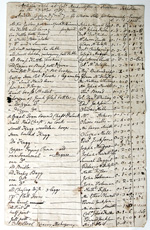 |
1785 Auction Records For an Innholder at Needham. Headed "Articles sold at Colo. Mackintoshes at Needham (Mass.) Innholder on the 23 Nov. 1785," 3½pp, 12¼ x 7¾ in. Listing the articles sold, to whom and for how much. There are many household items such as kettles, dishes, furniture, flat irons, curtains, blankets, a bridle, a saddle cloth, a candle box, a chocolate box, and a dictionary. Several military people are listed as buyers. Col. McIntosh signed that the total received was £12.5.9. Docket reads, "An Account of articles sold for Mr. Walter Logan in 1785, at Publick Auction." Good to very good; splits at horizontal fold, some contemporary stains at bottom, and light soiling, but very boldly written.
Estimated Value $750 - 850.
View details and enlarged photo
| Unsold |
Lot 101 |
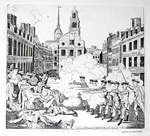 |
The Bloody Massacre. The Bloody Massacre perpetrated in King-Street, Boston, on March 5th 1770 by a party of the 29th Regiment Together with a Print of the event engraved by Paul Revere, the report from the Boston Gazette, and a note by Dr. Richard Hale. Barre, Mass.: The Imprint Society, 1970. 10¾ x 11¾ in. One of 1950 produced for the bicentennial of the Boston Massacre.
Estimated Value $200 - 300.
View details and enlarged photo
| Unsold |
Lot 102 |
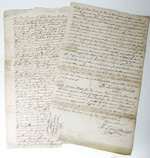 |
Boerum, Simon (1724-1775) Politician from Brooklyn, New York; represented NY in the Continental Congress. He helped defeat the Galloway Plan for union and reconciliation with Great Britain. His early death in July 1775 makes him one of the most difficult members of the Continental Congress to find. Rare Autograph Document Signed in the text, 4pp, 13 x 8 in., New York, Aug. 24, 1768. Being the Last Will and Testament of Weynant Bennet, who appoints Boerum as one of the three executors of the will. Usual folds, some minor marginal chips, some of which are repaired, else very good. Transcript of the will included. Boerum almost never comes on the market.
Estimated Value $600 - 900.
Ex Walter Benjamin Autographs, 1951; Collection of Henry E. Luhrs.
View details and enlarged photo
| Unsold |
Lot 103 |
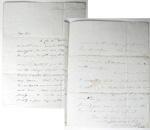 |
Burr, Aaron (1756-1836) Revolutionary War officer; Vice president of the U.S. (1801-05); killed Alexander Hamilton in a duel in 1804. Autograph Letter Signed ("A. Burr"), 3pp, 9¼ x 7 in., Albany, July 2, 1783. To an unidentified friend, announcing the birth of his beloved daughter Theodosia, on June 21: "On the 21st ult. Mrs. Burr presented me a sweet little girl…" He writes of the recipient's young charge who is visiting Burr's home and to whom he wishes to render "every service in my power" and adds that "Two or three gentlemen of Character propose going to Canada in a few days," then mentions a gift of some wine "which passes with our connoisseurs for old Madeira…." The text and signature are somewhat faded. Theodosia Burr (1783-1813) was raised by her father after the death of her mother when she was ten. He supervised her education and she acted as her father's hostess until her marriage to Joseph Allston, wealthy landowner and governor of South Carolina in 1801. Burr was charged with treason and tried in 1807. Although he was acquitted, he went to Europe for four years. After his return, Theodosia set sail to New York on December 31, 1812. Neither she nor the schooner Patriot was ever heard from again. Burr was devastated.
Estimated Value $800 - 1,000.
Christie's East, Nov. 24, 1998, Lot 141.
View details and enlarged photo
| Unsold |
Lot 104 |
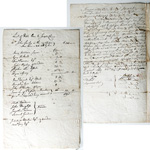 |
Chew, Joseph - Loyalist (1722?-1798) Appointed secretary to the Indian department due to the influence of Sir William Johnson; he fought on the Loyalist side, was captured near Long Island and paroled. Appointed agent for Canadian Indians in the 1780s. Manuscript Document Signed ("Jos Chew"), 2pp, 13 x 8½ in. May 23, 1766. Headed "List of Debts Due to Joseph Chew," the first page lists monies due Chew in the amount of 592 pounds. On the second page, Chew acknowledges that he is in debt to William Bayard & Company of New York and he assigns the debts due him to Bayard. Some bleed-through and erosion from iron-gall ink, both affecting Chew's signature. Chew lived in Connecticut and New York before the war.
Estimated Value $250 - 350.
View details and enlarged photos
| Unsold |
Lot 105 |
 |
Clymer, George and John Nixon. George Clymer (1739-1813) was a founding father who signed both the Declaration of Independence and the U.S. Constitution. John Nixon (1733-1808) was a financier and Revolutionary War officer who, on July 8, 1776, made the first public proclamation of the Declaration of Independence from the steps of the Pennsylvania State House. He served under George Washington at the Battle of Princeton, was a member of the Navy Board, and was with Washington at Valley Forge.
War-date Autograph Document Signed ("Geo Clymer") as Chairman of the Committee of Safety, one page, 4½ x 8 in., June 15, 1776. To John Nixon, on the Committee of Accounts, ordering him to "Pay to Mr. Joshua Tomlinson or order One hundred pounds being a premium allowed him for making public his knowledge of Grinding and boreing of Gun barrels." At lower left, Nixon wrote: "Mr. Rogers pay the above Amt. out of the Monies belonging to Congress. John Nixon." Defects at upper right affect a few letters; overall toning wear; backed with japan paper for conservation.
Estimated Value $1,500 - 2,000.
View details and enlarged photo
| Realized
$1,620 |
Lot 106 |
 |
[Cornwallis Surrender] The Continental Journal and Weekly Advertiser. Boston, December 14, 1781, 4 pp. Page 3 has lengthy letter, nearly two full columns, from Lord Cornwallis to Loyalist printer James Rivington, York-town, in Virginia, October 20, 1781, that begins "I have the mortification to inform your Excellency that I have been forced to give up the posts of York and Gloucester, and to surrender the troops under my command, by capitulation…as prisoners of war to the combined forces of America and France…" He continues with a detailed description of the battle and his correspondence with General George Washington. Other news includes a page 1 plea from "Merchants and Owners of ships taken by the English….,"a nearly full-page report from the British House of Commons about the impracticability of the American war and additional reports from Philadelphia, Hartford, and Boston. Some edge chipping to upper margins; small paper loss at top right corner of page 2 affects a few words; pages are separated, each with old mounting strip on verso. A very desirable issue.
Estimated Value $1,500 - 2,000.
View details and enlarged photo
| Realized
$1,080 |
Lot 107 |
 |
Dawes, Thomas (1757-1825) Jurist and alumnus of Harvard. He served in the Massachusetts Supreme Court from 1792 to 1802; his father, Thomas senior, was a Massachusetts militia colonel during the Revolution and afterward served in prominent positions in Massachusetts's government. Collection of five items, quarto or small quarto, two signed "Thos. Dawes," one "T. Dawes Jun." and one "Thomas Dawes Jun.r": A 1788 receipt regarding an estate; a 1786 ALS, 1p, Boston, to George Thacker regarding a legal matter; a 1791 ALS, 1p, n.p., Providence, to Benjamin Bourne, asking for a quick word with Bourne on a legal matter before Bourne leaves for New Haven; an 1824 ALS, 1p, n.p., to William Sullivan, mentioning painter Gilbert Stuart several times and a red robe Stuart had copied for a portrait. Condition of these four items overall very good; one seal tear affects a few words; some toning and edge chips. Accompanied by one Document Signed by Dawes father, also named Thomas, dated Jan. 31, 1759. It is an invoice of money due Dawes, in poor condition--stained, ragged at the bottom and separated at one fold, but Dawes' signature is nice and clean.
Estimated Value $250 - 300.
View details and enlarged photo
| Unsold |
Lot 108 |
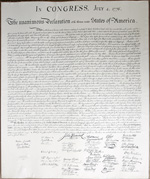 |
Declaration of Independence - Engraved by E.M. Weeks, 1939. Hand-engraved exact facsimile of the original Declaration, from a steel plate ordered by the Bureau of Engraving and Printing in 1936. Engraver Edward M. Weeks spent 1,318½ hours engraving the 26 x 31 in. steel plate that was finished in 1939. At lower left of the document is printed: "Facsimile of the Original / Engraved on Steel at the Bureau of Engraving and Printing by E.M. Weeks, Sc / 1939." Laid to board. The model for this intaglio print was from a photograph of the original Declaration of Independence taken by Levin C. Handy in 1903.
Estimated Value $1,200 - 1,500.
View details and enlarged photo
| Realized
$840 |
Lot 109 |
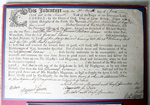 |
Early Document Referring to British Purchase of Brown Besses. Partly-printed Document Signed "Will: Evans" as Lt. Gen., one page, 7¾ x 11¾ in., June 13, 1734. An indenture between John, Duke of Argyll, Master General of His Majesty's Ordnance and Evans, by which Evans acknowledges receipt of 60 Land Service Muskets with brass furniture, 60 bayonets, and 60 pistols with brass furniture "to Arm the Additional Men to His Regiment of Dragoons now Ordered to be rais'd."
The first model British Brown Bess musket was adopted in the early 1730s, making this one of the earliest documents referring to the Brown Bess. The Land Service musket, called Brown Bess, was used for over 100 years during the expansion of the British Empire, having tremendous symbolic, as well as physical, importance. General Evans came to prominence when he served in Flanders during the War of the Spanish Succession and acquired a regiment of dragoons. He was promoted to Lt. Gen. in 1727.
Estimated Value $1,500 - 2,000.
View details and enlarged photo
| Unsold |
Lot 110 |
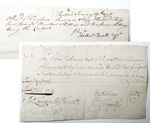 |
Ellsworth, Oliver (1745-1807) A drafter of the United States Constitution; third Chief Justice of the United States. Document Signed ("O. Ellsworth") as a member of the Connecticut Paytable, one page, 5 x 8¼ in., Hartford, Jan. 29, 1776. To John Lawence, treasurer, ordering him to pay Capt. Nathaniel Buel, Paymaster of the 4th Company of the 4th Connecticut Regiment, the "Sum of Seven Hundred forty four pounds Nineteen Shillings & two pence in Bills & charge the Colony." Capt. Buell signed on the verso that he received the funds on the same day. An Ellsworth document with the magical date of 1776!
Estimated Value $400 - 600.
View details and enlarged photos
| Realized
$246 |
Lot 111 |
 |
Expenses For the Lexington Alarm, Col. John Baker's Regiment. Manuscript document listing expenses for food purchased April 20th, May 19th, and June 5th, 1775, to feed Col. Baker's regiment, 3½ x 7¾ in. On the verso is "Jno Bakers Acco.t, allowd." The list includes "April 20th the Town of Ipswich to John Baker…Bread…to Mager Gould for the Army…" It also lists beef and bread delivered to Capt. Staniford for the army; on May 19th, potatoes and bread "to ye Army"; and again, on June 5th, bread, "3 flour Barrels Supplyd the Army…Bread Deliv.d t Mr. Rindge & Mr. Smith on the late Alarm…Provision & Drink on ye alarm…." Fine. Col. Baker's regiment was part of Capt. Joseph Gould's Company in the Topsfield Militia. They marched on the Lexington Alarm on April 19, 1775 but did not see active service that day because the battle was over before they arrived.
Estimated Value $600 - 800.
View details and enlarged photo
| Realized
$600 |
Lot 112 |
 |
Gage, Thomas (1719/20 20-1787) Commander-in-chief of the British forces in North America (1763-1775). Appointed military governor of the Massachusetts Bay Colony in 1774, it fell to him to punish Massachusetts for the Boston Tea Party by implementing the Intolerable Acts. When he attempted to seize military stores of Patriot militias in April 1775, the Battles of Lexington and Concord ensued, beginning the American War of Independence. General William Howe replaced him after the Battle of Bunker Hill and Gage returned to England. Manuscript Document Signed ("Thos Gage") as Commander in Chief of His Majesty's Forces in North America, one page with separate docket leaf, 12½ x 7¾ in., New York, April 4, 1770. An order to Francis Stephens, Storekeeper and Paymaster of His Majesty's Ordnance at New York: "You are hereby directed and required to deliver to one of the Artificers going to Niagara Three Foot Tents compleat, for the use of Seven Carpenters and eight Masons to be employed in building new Blockhouses, and other works at Niagara…." With the end of the French and Indian War in 1763, Fort Niagara fell into disrepair. A stockade was added in 1768 to provide protection against an Indian attack and in 1770-71, two stone redoubts were added. The tents ordered by Gage were the workmen sent to build the redoubts and the tents were for their use.
The storekeeper and paymaster obviously kept Gage's order, which had two nice blank pages, for some notes of his own. On the verso of both pages are Revolutionary War-date notes about supplies, beginning in November 1776 and ending May 25, 1779. In 1776, the writer notes livestock, guns, clothing, etc., "Lost by the Enemy" (America being the enemy). There are notations from 1777 and 1778 and a full page of entries for May 25, 1779 losses, which include many supplies, and four horses, "Lost by taken up the Bredge by Cap Diceson order Col. Clarke Reg[i]ment Car[o]lina men when the Enemy was persuing John Demarest with the Effects." The page with Gage's order is very good. The page with the docket and the verso of both pages are stained and some items faded, but overall legible. A very interesting lot!
Estimated Value $2,750 - 3,000.
View details and enlarged photos
| Unsold |
Lot 113 |
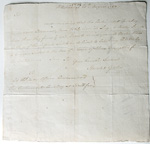 |
Gates, Horatio (1728-1806) Revolutionary War general; with the help of Benedict Arnold forced Burgoyne's surrender at Saratoga; took part in the Conway Cabal; was examined by Congress for his diastrous defeat at Camden. Rare war-date Autograph Letter Signed, one page, 8 x 8 in., Hillsborough, Aug. 25, 1780. Written nine days after the debacle at Camden, where his army was routed and some 1,000 men were captured, along with the army's baggage train and artillery. "To Col. White or Officer Commanding The Continental Cavalry at Hallifax." In full: "Understanding that the Continental Cavalry under your Command, have lately received Longer, & Better Swords, than those they formerly had, I am to desire you will Order those in Store of this inferior Sort, to be deliverd to Col. Long D.Q[uarter] M[aster] G[eneral] to be appropriated to the use of a Corps of Horses Draughted from The Militia." Trimmed slightly at top; partial split at vertical fold. Text and signature somewhat light but legible.
Estimated Value $2,000 - 2,500.
View details and enlarged photo
| Realized
$2,400 |
Lot 114 |
 |
George I - Document Signed Regarding 23rd Royal Welsh Fusiliers (1660-1727) King of Great Britain and Ireland (1714-1727). Document Signed ("George R"), one page, 12 x 7¾ in., Court at St. James, March 19, 1719/20. A document authorizing John Crosse of the Royal Regiment of Welsh Fuziliers, commanded by Major General Joseph Sabine "to Exchange his Commission of Second Lieutenant in that Regiment." Accompanied by a vintage engraving. Normal folds, light toning and soiling, else fine. Very bold signature.
The Royal Regiment of Welsh Fusiliers was the 23rd regiment, which was very involved in the Battle of Lexington and Concord. Lieutenant Frederick MacKenzie of the Fusiliers wrote one of the most famous accounts of that battle. Sir William Howe was a former colonel in the Royal Welsh Fusiliers. He was Commander of His Majesties Forces in North America at the time of the Battle of Bunker Hill.
Estimated Value $1,200 - 1,500.
View details and enlarged photos
| Unsold |
Lot 115 |
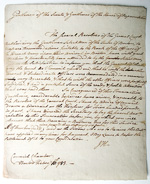 |
Hancock, John (1737-1793) First Signer of the Declaration of Independence; president of the Second Continental Congress; Goveror of Massachusetts. Autograph Letter Signed with his initials ("JH") as Governor of Massachusetts, 1p, 9¾" x 8 in., Council Chamber, Boston, Feb. 10, 1783. Hancock's retained draft, addressed to "Gentlemen of The Senate, & Gentlemen of the House of Representatives," requesting additional funds to reimburse citizens who had billeted the French army as they prepared to leave America at the end of the Revolution.
In full: "The several Resolves of the General Court, authorizing the Gentlemen Selectmen of the Town of Boston, to prepare Accomodations suitable to the Rank of the Officers of the French Army upon their Arrival in Boston, have with great attention & punctuality been attended to by the Selectmen. I have the Satisfaction to inform you that the General of that army the Count De Viomenil assur'd me, that he with the other General & Subordinate officers were accommodated in a manner very agreeable, & that he with the other officers were perfectly Satisfied, & had a grateful Sense of the ready & polite attention that was paid them. In Consequence of this Transaction, Gentlemen, considerable Expences have arisen, & agreeable to the Resolve of the General Court, I have by Advice of Council drawn a Warrant on the Treasure for Five hundred pounds, in part, I have Directed the Secretary to lay the several Accnts. relative to this Transaction before you, by which you will observe that there Remains a Balance due for this Service of Four hundred & nine pounds & three shillings & six pence and as the Persons who are to Receive this Ball[an]ce have applied many times for payment, I Beg Leave to Refer the Settlement of it to your Consideration. JH"
On September 23, 1782, the French army left Williamsburg, Virginia, where it had been instrumental in Cornwallis' surrender at Yorktown on October 19, 1781, and set out for Boston, where it would embark for the West Indies. The Comte de Rochambeau bid farewell to his troops at Providence, Rhode Island and turned over his command to the Comte de Vioménil. The French entered Boston on December 7 and set sail on December 24.
Estimated Value $5,000 - 6,000.
Ex The Hancock-Chase Collection. Sold at Butterfield, June 27, 2001, lot 9084, $4,000.
View details and enlarged photo
| Unsold |
Lot 116 |
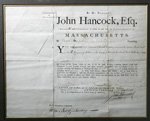 |
Hancock, John (1737-1793) Signer of the Declaration of Independence; President of the Continental Congress during the debates about and the signing of the Declaration of Independence; Governor of Massachusetts. Partly-printed Document Signed as Governor of Massachusetts, one page, 12 x 15½ in., Boston, Sept. 1, 1784. Appointing "Joseph Sears Gentleman…First Lieutenant of the sixth Company commanded by Captain Isaiah Hall in the first Regiment of Militia in the County of Barnstable whereof Enoch Hallet Esqr. is Colonel…." Countersigned by John Avery as Secretary. Laid paper has some fold wear and separations; a vertical fold passes through the tail of the "J" in "John". The paper seal is intact at upper left and the signature is a beautiful example. Archivally matted and framed with an engraving of Hancock to an overall size of 19 x 29 in. An impressive display item.
Estimated Value $3,000 - 5,000.
View details and enlarged photo
| Realized
$3,240 |
Lot 117 |
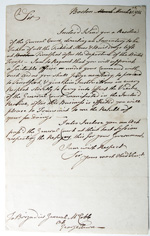 |
Hancock, John. Autograph Letter unsigned, one page, 12 x 7¼ in., Boston, Mar. 31, 1784. Hancock's retained copy to Brigadier General Cobb at Georgetown: "Inclos'd I send you a Resolve of the General Court, directing an Inventory to be Taken of all the Publick Stores & Buildings left at Penobscot after the Departure of the British Troops. I am to Request that you will appoint a suitable officer under your command with such aid as you shall Judge necessary, to proceed to Penobscot, & give him Instructions in every Respect strictly to Carry into Effect the Views of the General Court manifested in the Inclos'd Resolve [not present], after this Business is effected you will please to Transmit to me the Result of your Doings. I also Inclose you an Act pass'd the General Court at their last Session respecting the Refugees, this for your government…." Fine. Brigadier General David Cobb was a Lt. Col in Jackson's regiment in 1777 and 1778; he served in Rhode Island and New Jersey and was aide-de-camp on the staff of General George Washington. In 1786 he was appointed major general of militia and rendered conspicuous service during Shays' Rebellion.
Estimated Value $1,200 - 1,500.
View details and enlarged photo
| Realized
$1,860 |
Lot 118 |
 |
Harrison, Benjamin (1726-1791) Signer of the Declaration of Independence; Governor of Virginia (1781-1784). Manuscript Document Signed ("Benj. Garrison"), one page, 9 x 7¼ in. (Richmond), April 20, 178? (date illegible). Harrison certifies that Francis Watkins, whose Sept. 15, 1783 attestation regarding a judgment is on the verso, is clerk of the court of Prince Edward County and that "our faith and credit ought to be given to all things by him so attested…." Seal is present at upper left. The document is in poor to fair condition due to dampstaining; fold repairs on verso. Still, Harrison was a signer of the Declaration of Independence.
Estimated Value $300 - 500.
View details and enlarged photo
| Realized
$300 |
Lot 119 |
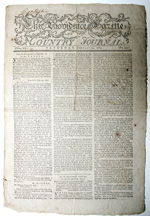 |
Jan. 25, 1783 The Providence Gazette and Country Journal. Printed in Providence by John Carter and the personal copy of Capt. John Hopkins, whose name is in the upper left corner. Capt. Hopkins was a Rhode Island-based sea captain who was assigned command of one of the longboats that, together with seven other such boats, attacked and burned the HMS Gaspee in 1772. The front page article by Doctor Walter is about New England's failure to continue to help pay for the war. Another article is about the virtue of a free Government run by the people. Page two has news of the war, including news from Richmond, Virginia, as well as battles at sea. Page three has an extract of a letter from John Adams dated Hague, July 5, 1782. Minor foxing; wear to upper half of vertical fold affects several words, most legible. A scarce Rhode Island Revolutionary with a historic connection to the burning of the famous ship Gaspee.
Estimated Value $500 - 600.
View details and enlarged photo
| Unsold |
Lot 120 |
 |
Laurens, Henry (1724-1792) Third President of the Second Continental Congress (November 1, 1777-December 9, 1778). Named minister to Holland in fall of 177, he negotiated Dutch support for the American Revolution. He was taken prisoner on his way home and held in the Tower of London until lDecember 31, 1781, when he was exchanged for General Cornwallis. In 1783 he acted as one of the peace commissioners for the negotiations leading to the Treaty of Paris.
Autograph Document, one page, 6½ x 8 in., n.p., n.d. Titled "Killed Wounded & Missing in the Action of the 20th June 1779 when the British Troops were attacked at Stono ferry in their Lines & Redoubts--two of the latter were fairly enter.d by the Carolina Troops." He lists by rank 34 killed, 155 wounded and 9 missing, whom he conjectures, "will probably be heard of at home." At lower left he notes, "This I believe is the first instance of attack upon the Enemy's Lines in America--had there been no blunder at James Island the victory would probably have been complete. At lower right he writes, "The enemy left on the ground--1 Tory Colonel, 1 Highland Captain, 24 inferior perhaps R & F had many killed & wounded within Redoubts & intrenchment." The American forces were under General Benjamin Lincoln.
An enclosed copy of a 1994 letter from David Chesnutt at the University of South Carolina confirms that the casualty list is in the hand of Henry Laurens, who was in Philadelphia in 1779 but would have made the list based on information he received from Charleston. Toned, else fine.
Estimated Value $750 - 1,000.
View details and enlarged photo
| Unsold |
Lot 121 |
 |
Letters From Prison, Written by a Former Revolutionary War Officer. William Barton (1748-1831) Enlisted as a corporal in the Continental Army (1775) and fought at Bunker Hill; in 1777, as a major in the Rhode Island militia, he captured British Maj. Gen. Richard Prescott during a raid, for which he was promoted to Lt. Col and honored by a resolution of the Continental Congress. In 1812, Barton was imprisoned in Danville, Vermont, over a land dispute. This collection consists of five handwritten copies of letters (approximately 8 pp) written by Barton between 1818 and 1829, from prison (Limits of Danville), to various leading men and organizations regarded some facts about his case that have been entered in error. A couple of excerpts: "…pray you pay attention to an old officer who fought and bled for his country before some of you was born….I am a citizen of Rhode Island who has been confined in prison in the place for more than 8 years for lands that were deeded to him by yur Superior Court…." Letters have folds and some light soiling; overall very good. Barton spent almost 13 years in prison, finally being released at the age of 77, when the visiting Marquis de Lafayette agreed to pay the balance of his fine. Fort Barton in Rhode Island is named after William Barton.
Estimated Value $800 - 1,000.
View details and enlarged photo
| Unsold |
Lot 122 |
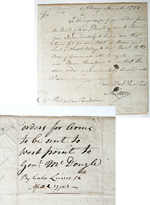 |
Lewis, Morgan - An Order to Ship Arms to West Point Re The Great Chain (1754-1844) Son of Francis Lewis, a signer of the Declaration of Independence. From September 1, 1776 to the end of the war Morgan was a colonel and the Quartermaster General for the Northern Department. He later served as New York State Attorney General, Justice and Chief Justice of the Supreme Court of New York, and from 1804 to 1807 was governor of New York. Manuscript Document Signed ("M Lewis") as Quartermaster General for the Northern Department, one page, 7¼ x 7¼ in., Albany, April 16, 1778. To Mr. Philip Van Rensselaer: "In Consequence of an order from the Board of War, Directing me to Desire you Immediately to have all the Arms fit for use, put in Boxes and Sent without Delay, to West Point to the Order of General McDougal, you will Please therefore to see that the above order is Immediately Complyd with…." Toning and a couple of contemporary ink stains, one affecting the "M" in the signature.
On April 30, 1778, a heavy chain ("The Great Chain") supported by enormous logs was extended across the Hudson River to prevent British ships from moving north of West Point. The distinctive "S-Curve" the Hudson makes there would force any large ship to slow down in order to navigate it, thus making the ship an easier target for artillery batteries. Cannons were placed in forts and batteries on both sides of the river to destroy any ship that aproached the obstacle of The Great Chain. The chain remained in place until 1782. In this order, Col. Lewis stresses the urgency of getting all arms to West Point immediately; the chain would go in place 14 days after this order.
Estimated Value $1,000 - 1,250.
View details and enlarged photos
| Realized
$930 |
Lot 123 |
 |
Livingston, Philip (1716-1778) American merchant and statesman from New York City. He was a delegate for New York to the Continental Congress from 1775 to 1778, and signed the Declaration of Independence. Manuscript Document Signed ("Phil. Livingston"), 2¼ x 6¼ in., New York, June 9, 1764. Acknowledging receipt of £125.15.11¾ from Mr. Solomon Pinto and also the discharge of a note for Jared Ingersol, who had sent the money owed Livingston by Mr. Pinto. Inlaid to a slightly larger sheet. Boldly signed.
Estimated Value $800 - 1,000.
View details and enlarged photo
| Realized
$1,050 |
Lot 124 |
 |
Maxwell, William (1733-1796) Brigadier general during the American Revolution, commanding the New Jersey Brigade, which took part in the defense of Philadelphia, fought at the Battle of Cooch's Bridge before Brandywine, served as the reserve at Germantown, and fought at the Battle of Monmouth. He took part in the 1779 Sullivan Expedition, taking over when Sullivan fell ill. Document Signed ("W. Maxwell") as Deputy Commissary of Detroit, one page, 8½ x 8 in., Detroit, Sept. 27, 1766. An affadavit regarding the condition of some rotting barrels of liquor and wine from the estate of the late Joseph White, a merchant from Albany. Also signed by Edward Mumford and George Knaggs. Overall fine.
Estimated Value $250 - 350.
View details and enlarged photo
| Realized
$110 |
Lot 125 |
 |
Paine, Robert Treat (1731-1814) Massachusetts statesman and Signer of the Declaration of Independence. Autograph Letter Signed ("R T Paine"), one page, 4 x 7½ in., Taunton (Mass.), Jan. 14, 1762. With holograph address to Mrs. Mehetabel Perry at Easton, regarding a debt of about 20 shillings which her late husband owed to Mr. Richard Mann of Midfield and "which must be sued if not paid soon." Normal folds and minor contemporary ink brushing to signature. Boldly penned and signed.
Estimated Value $500 - 600.
View details and enlarged photo
| Realized
$276 |
Lot 126 |
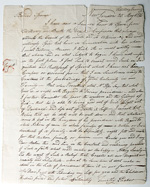 |
Parker, Timothy - Commander of the Oliver Cromwell (1735-1797) U. S. naval officer; commander of the famous ship, Oliver Cromwell. Autograph Letter Signed, one page, 10 x 8 in., New London, May 25, 1776. On the eve of the launching of the Oliver Cromwell, on which he would serve at 1st Lt. at this time, Parker writes to his beloved wife, Deborah, in Norwich, and shares his feelings with her. In part: "…I feel such a vacant mind such an Inquietude and Restlessness of Spirit which I know not how [to] Compose or account for…But when I recollect what Mr. [Alexander] Pope says--that what Ever is is right with Reguard to Divine providence--and when I further Consider the power the wisdom and goodness of God--I cannot but Believe that all he doth will be well done…with Regard to whole Nations of men or whole familys of a nation or Individuals of a family…." Archival repairs on verso; seal tear affects three letters; split from top edge affects two words. Boldly penned and signed.
Earlier in 1776, while serving as 1st Lt. on the "Spy," Parker had been put in charge of the prize ship "Hope," which was retaken by the British and Parker was sent to a prison ship in New York City. Upon his request, Gov. Trumbull arranged an exchange in December 1776. In December 1777, Parker took over command of the Oliver Cromwell and took numerous prizes until the Cromwell was taken by the British in August 1779; Parker was once more captured and exchanged. At that time, he began privateering as commander of the Scourge and later of the Prudence and the Hancock. No wonder Parker had trepidations when he wrote this letter to his wife!
Estimated Value $1,000 - 1,250.
View details and enlarged photo
| Unsold |
Lot 127 |
 |
Payment Order For A Mulatto Soldier From Connecticut in the Continental Army. Partly-printed Document Signed by Finn Wadsworth for the Connecticut Paytable, one page, 6¾ x 7¼, Dec. 17, 1782. Ordering the treasurer, John Lawrence, to pay Abel Scipio thirteen pounds three shillings and two pence, "for Service in the Continental Army in 1781…." Elijah Flower signed on the verso in receipt of payment for Scipio. Light soiling and some edge splits at folds. Abel Scipio is listed in David 0. White's Connecticut's Black Soldiers, 1775-1783 (1973). Scipio was a member of the Farmington regiment from 1771 until 1781.
Estimated Value $600 - 800.
View details and enlarged photo
| Realized
$360 |
Lot 128 |
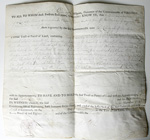 |
Randolph, Edmund (1753-1813) Governor of Virginia, 2nd U.S. Secretary of State, and 1st U.S. Attorney General. Partly-printed Document Signed as Governor of Virginia, one page, vellum, 12¾ x 14 in., Richmond, Oct. 19, 1787. Granting John Lockridge 92½ acres of land in Greenbrier County. Vellum is lightly toned and translucent in a few areas, including under first name in signature; "Randolph" is somewhat light but quite large. Seal is intact at lower left.
Estimated Value $250 - 350.
View details and enlarged photo
| Unsold |
Lot 129 |
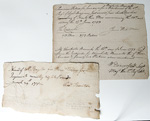 |
Revolutionary War Documents for Virginia Light Dragoons. Provision Return for the Virginia 1st Regt. of Light Dragoons signed by future governor James Wood as Col. Com., 6½ x 8 in., Winchester Barracks, 1783. "Provision Return for four days for a Detachment of the 1st Regt. of Light Dragoons Just arrived from South Carolina consisting of Ninety three men commencing the 13th and ending the 16th June 1783." W. Dangerfield Sergt., Maj. 1st Reft. Lt D., signs at bottom that he received 372 rations from the contractor for Winchester Barracks on June 16, 1783. Very good; clearly and boldly written. Documents of dragoon regiments of Virginia involved in the Southern Campaign are rare. Accompanied by an Autograph Document Signed by Francis Thornton, 4 x 8 in., n.p. "Receivd of Coll. Baylor for three Horses for the Regiment ninety eight Pounds. March 24th, 1771." Thornton belonged to Cornet Lee's battalion of light dragoons. Good; document is stained and toned.
Estimated Value $800 - 1,000.
View details and enlarged photo
| Realized
$2,220 |
Lot 130 |
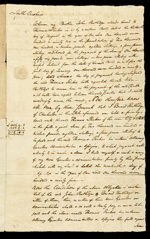 |
Rutledge, Edward (1749-1800) Youngest Signer of the Declaration of Independence; governor of South Carolina. Document Signed ("Ed: Rutledge"), two pages plus integral leaf with docket, 13 x 8¼ inches, Charleston, April 20, 1795. In part, "Whereas my brother, John Rutledge stands bound to Thomas Parker in & by a certain Bond dated the thirteenth day of August, in the year of Our Lord one thousand seven hundred and ninety-two in the penal sum of Two thousand one hundred and twelve pounds eighteen shillings & four pence…the day of payment having elapsed the said Thomas Parker hath requested the said John Rutledge to secure him in the payment of said debt & it hath been agreed between the said parties that I should accordingly secure the same…." Several edge splits at folds, easily repaired. After signing the Declaration of Independence, Edward returned to South Carolina and took a seat in the state Assembly. He was a captain of militia and fought in the Battle of Beaufort in 1779. In 1780 he was captured by the British during the fall of Charleston and held prisoner until July 1781. Edward's brother, John (1739-1800) was a statesman, jurist, and President of the South Carolina General Assembly.
Estimated Value $500 - 600.
View details and enlarged photos
| Realized
$1,140 |
Lot 131 |
 |
[Society of the Cincinnati] Eagle Insignia. Gold eagle that belonged to Elihu Church (1881-1963), who became a member of the New York chapter of the Society of the Cincinnati in 1912 by right of descent from original member James Stewart, Captain, 5th Regiment, NY Line. Church was the first, and apparently only, hereditary member on this line. He did not inherit membership from his father, so he would have acquired himself any eagle that he owned. He likely first purchased a New York eagle, since this was the society to which he belonged. He served as president of the New York chapter of the Society of the Cincinnati in 1938.
This eagle is c. 1940s, in the style of Myers #67, which is a variation on the Connecticut eagle (#66, made by Braxmar & Co.). The gold is probably 14-18 karat gold based. Height: 41.64 mm. Width: 30.50mm. Obverse: Head to left, red eye, distinct crest to head, white enamel on tail; green enamel on wreath and branches. Tiffany medallion with gold on white: "OMNIA: RELINQUIT: SERVARE: REPUBLICAM" and showing three senators presenting a sword to Cincinnatus, whose wife and two children are behind him. Angle of roof points to "R" in "SERVARE." Reverse: Tiffany medallion with Cincinnatus at plow, Fame above, sunrise behind, and ship and building in distance; motto is "SOCIETAS: CINCINNATORUM: INSTITUTA: AD 1783." Tail has three layers, each with five leaves enameled white.
From the late 19th century, eagles were no longer handmade but cast from dies. The two-sided medallion is separate from the eagle itself; made in two pieces from two dies, it was then attached to the eagle. The enamel on the medallion, or other decorations, were customized, but the die-based attributes remained the same. Dates given in Myers (The Insignia of the Society of the Cincinnati by Minor Myers, Jr., 1998) usually refer to the first year a particular eagle design was used but the dies were used for years afterwards.
Estimated Value $3,500 - 4,500.
Estate of Elihu Church.
View details and enlarged photos
| Realized
$11,400 |
Lot 132 |
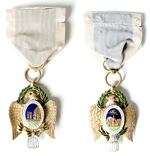 |
[Society of the Cincinnati] Eagle Insignia. Gold eagle that belonged to Elihu Church (1881-1963), who became a member of the New York chapter of the Society of the Cincinnati in 1912 by right of descent from original member James Stewart, Captain, 5th Regiment, NY Line. Church was the first, and apparently only, hereditary member on this line. He did not inherit membership from his father, so he would have acquired himself any eagle that he owned. He likely first purchased a New York eagle, since this was the society to which he belonged. He served as president of the New York chapter of the Society of the Cincinnati in 1938.
This is a Tiffany eagle, c. 1940s, being a variation on Myers #51 (which is New York, c. 1900, following the basic design of the Rhode Island Tiffany eagle). The gold is probably 14-18 karat gold based. Height: 43.65 mm. Width: 31.79 mm. The eagle is suspended from a pale blue and white cockade ribbon which is attached to a segmented ring which is looped through a small plain ring.
The General Society of the Cincinnati was founded in New York in 1783 by Continental Army officers who fought in the American Revolution.Within a year, affiliated Societies were founded in all 13 of the original states and France. George Washington was elected the first President in December 1783 and served until his death in 1799, when he was succeeded by Alexander Hamilton.
The Society was named for Lucius Quintus Cincinnatus, a 5th century B.C. Roman farmer who, like Washington, triumphantly lead his country's troops in battle, then returned home to plow his fields, refusing any honors. The Society's motto is: "He gave up everything to serve the republic." The Society of the Cincinnati is the oldest military hereditary society in the United States. Membership passes through the eldest son of the eldest surviving son successively of an original member. The Society was also the first military beneficial society. At a time when there were no military pensions, officers who were original members of the Society were required to give one month's pay, the interest of which was used for needy officers and their families.
Estimated Value $2,500 - 3,500.
Estate of Elihu Church.
View details and enlarged photos
| Realized
$11,400 |
Lot 133 |
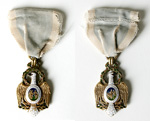 |
[Society of the Cincinnati] Eagle Insignia. Gold eagle that belonged to Elihu Church (1881-1963), who became a member of the New York chapter of the Society of the Cincinnati in 1912 by right of descent from original member James Stewart, Captain, 5th Regiment, NY Line. Church was the first, and apparently only, hereditary member on this line. He did not inherit membership from his father, so he would have acquired himself any eagle that he owned. He likely first purchased a New York eagle, since this was the society to which he belonged. He served as president of the New York chapter of the Society of the Cincinnati in 1938.
This is a New York eagle, c. 1919. The gold is probably 14-18 karat gold based. Height: 40 mm. Width: 24 mm. The eagle is suspended from a pale blue and white ribbon which is attached to a segmented ring which is looped through a smaller plain ring. The New York eagle used the L'Enfant design (rather than the 1902 design) which was worn by the founders of the society. Later specimens were made by Bailey, Banks & Biddle of Philadelphia, then by A.M. Ross.
George Washington was elected the first President of the Society of the Cincinnati in December 1783 and served until his death in 1799, when he was succeeded by Alexander Hamilton. Original Members of the Society of the Cincinnati included General Henry Knox, considered the Society's originator; General Friedrich William von Steuben, the Society's first presiding officer; Alexander Hamilton; General Nathanael Greene; Commodore John Barry; and Captain John Paul Jones. Foreign officers who fought in the American Revolution also became members. They included Generals Lafayette and Rochambeau and Admiral de Grasse from France, and Colonel Thaddeus Kosciuszko from Poland.
Estimated Value $2,000 - 3,000.
Estate of Elihu Church.
View details and enlarged photos
| Realized
$1,200 |
Lot 134 |
 |
[Society of the Cincinnati] French Miniature Eagle Insignia. H: 26.15. W: 14.26. c. 1920. Suspended from a pale blue and white ribbon with a rosette button, attached by a larger loop to a smaller loop at the top of the eagle. Obv: Head left with distinct crest; neck elongated; white enamel on neck and diamond-shaped tail. On painted medallion, Cincinnatus with senators. Motto in gold letters on blue enamel: VIRT PRAEM SOC CINC INST 1783. Reverse: Cincinnatus at plow in medallion. Gold letters on blue enamel background: OMN RELINQ SERV REMP.
At the first meeting of the Society of the Cincinnati in May 1783 it was decided that officers of the French Army and Navy above certain ranks would also be able to join; consequently, the French Society of the Cincinnati was organized on July 4, 1784. Even though King Louis XVI had not allowed his officers to wear any foreign decorations, he made an exception in favor of the badge of the Cincinnati. French members included Generals Lafayette and Rochambeau and Admiral de Grasse.
Estimated Value $400 - 600.
Estate of Elihu Church.
View details and enlarged photos
| Realized
$1,980 |
Lot 135 |
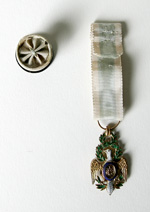 |
[Society of the Cincinnati] French Miniature Eagle Insignia. H: 26.15 mm. W: 14.26 mm. c. 1920. Suspended from a pale blue and white ribbon attached by a larger loop to a smaller loop at the top of the eagle. Separate rosette button. Obv: Head left with distinct crest; neck elongated; white enamel on neck and diamond-shaped tail. Cincinnatus receives sword from two senators. Motto in gold letters on blue enamel: VIRT PRAEM SOC CINC INST 1783. Reverse: Cincinnatus at plow in medallion. Gold letters on blue enamel background: OMN RELINQ SERV REMP.
At the first meeting of the Society of the Cincinnati in May 1783 it was decided that officers of the French Army and Navy above certain ranks would also be able to join; consequently, the French Society of the Cincinnati was organized on July 4, 1784. Even though King Louis XVI had not allowed his officers to wear any foreign decorations, he made an exception in favor of the badge of the Cincinnati. French members included Generals Lafayette and Rochambeau and Admiral de Grasse.
Estimated Value $400 - 600.
Estate of Elihu Church.
View details and enlarged photos
| Realized
$252 |
Lot 136 |
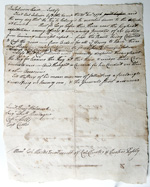 |
Testimony For A Court Martial Regarding the Dec. 26, 1776 Battle of Trenton. Manuscript document unsigned, one page, 10½ x 8½ in. n.p., n.d. To Lieut. Benj. Holcomb, Serft Joh.th Montague, Capt. Mills, and Capt. Curtis, soliciting testimony regarding an unauthorized leave taken by one Col. Johnson on the day his regiment left for the battle of Trenton.
"Jno Johnson leave--Testify That Col. Johnson left the Camp the 25th Dec.r 1776 and the very day that the Reg. he belonged to marched down to the attack at Trenton--That for Days before this, there were the highest expectations among officers & even among privates of an action…from the Boats being collected to cross the river--from Orders for all ye Army to have three days Provisions ready cooked …25th Dec.r From Gen.l Sullivans Address to Col Chesters Regiment. Testify that Col Johnson was generally despised throughout the Reg. for leaving the Reg. at this time & under these circumstances--and thought a coward for his conduct on this & other Occasions. Tell the story of his mean manner of solliciting a furlough & insisting on having one, & the Generals short answers." At the bottom of the page is "Memo Col Wards Treatment of Col. Chester & Chesters Reply." The page is stained and toned. This was obviously one page among several regarding Johnson's dereliction of duty.
Estimated Value $1,800 - 2,000.
Ex: Joe Rubinfine.
View details and enlarged photo
| Realized
$1,920 |
Lot 137 |
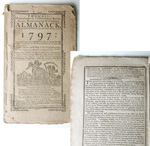 |
Thomas's Almanack, Printed by Isaiah Thomas, 1797. Full and complete issue of Thomas's Almanack for the year 1797, 48 pages, 7¾ x 4 in. Printed at Worchester, Massachusetts by Revolutionary War patriot Isaiah Thomas, who played a critical role in rousing the people of Massachusetts to resist British rule. When he used his paper, The Massachusetts Spy, to stir people to action, the British sought his arrest and execution. He smuggled his press from Boston to Worcester, where he continued to publish. After the war, Thomas became the foremost publisher and printer in America. This very scarce edition contains the complete printing of President George Washington's historic Farewell Address, given when he stepped down from the Presidency. Toned with some edge wear but otherwise very good.
Estimated Value $400 - 600.
View details and enlarged photos
| Unsold |
Lot 138 |
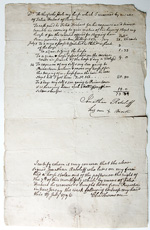 |
Thomson, Charles (1729-1824) Patriot leader and sole the secretary of the Continental Congress (1774-1789); with William Barton he designed the Great Seal of the United States. Autograph Document Signed ("Chas Thomson"), one page, 12½ x 8 in., n.p., July 27, 1796. A document certifying that one Jonathan Ratcliff, who had a horse stolen from him, lived on Thomson's farm, and that Ratcliff recovered the horse the following week from Felix Herbert. Thomson lists Ratcliff's expenses in going to Princeton to recover the horse. Very good; toned and lightly soiled; some edge splits. Boldly penned and signed.
Estimated Value $600 - 800.
View details and enlarged photo
| Unsold |
Lot 139 |
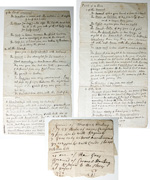 |
Two Early Gun-Related Documents, One Regarding Committee of Safety Muskets. Manuscript Document, 3½ x 4 in., reads in part, "Received of Hezekiah Hunting Esq. 38 stands of armes compleat, 9 fine Locks with Bayonets, 7 Guns only without accouterment…21…of the Guns Received of Coronel Hunting Esq Returnd to the stores at Hartford." Merrill Lindsay's book The New England Gun notes a Hezekiah Huntington from Windham, Ct. as a Committee of Safety maker. This is probably the same person and the piece show that he actually delivered arms in accordance with the Committee of Safety.
The second piece is a treatise on gunsmithing, 8¼ x 4½ in, with instructions on both sides. It seems to be late 18th century and describes the flintlock mechanism. It breaks down the parts of the barrel, the lock, and the stock, and gives the advantages/disadvantages of using a blunderbuss, a fowling piece, a rifle, smooth-bored guns, and pistols. Two rare Revolutionary War manuscripts regarding guns.
Estimated Value $1,200 - 1,500.
View details and enlarged photos
| Unsold |
Lot 140 |
 |
(Wayne, Anthony). Autograph Letter Signed by R. Brownfield, one of the doctors in General "Mad Anthony" Wayne's army, 2½pp, 10½ x 8 in. (Georgia), Aug. 7, 1782. To The Hon.ble Brig.r Gen.l Wayne in Savannah. In part: "…the situation of the hospital will I hope sufficiently apologize for my giving you further trouble at a time when your preparations for leaving Savannah may make it inconvenient for you to attend to it. The sick amount now near to 200 many of them very ill. Several patients are in a low debilitated state & I think cannot recover….The bearer waits on you to complain of the injuries done his barns…I assert that nothing in or about his houses have been wantonly injured or any one altercation made but what was absolutely necessary for the welfare of the sick…he had confidence to say that he would rather burn his barns than have soldiers in them….am now informed of your intention to go on water. Accept my congratulations on the full conquest of Savannah…." Good condition; paper is toned with extensive chipping at right margins, affecting several letters. The formal surrender of Savannah occurred on July 11, 1782. In appreciation of Wayne's service, Georgia appropriated 3900 guineas to purchase an estate for him.
Estimated Value $600 - 800.
View details and enlarged photo
| Unsold |
Lot 141 |
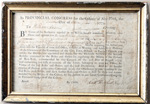 |
Woodhull, Nathan (1722-1776) President of the New York Provincial Congress; brigadier-general of the New York Militia; martyr to the American cause. Partly-printed Document Signed ("Nath.ll Woodhull") as President of the New York Provincial Congress, one page, 8 x 12 in., Oct. 17, 1775. Appointing William Adams "second Lieutenant of the second, or Grenadier Company (in the second Battalion formed of Independent Companies of Militia in the city of New York) whereof John Laboyteaux Esquire is Captain…." Countersigned by Robert Benson, Secretary. Good; document is worn and toned; a vertical fold runs through the "od" in "Woodhull." Housed in an old frame; overall size is 9½ x 14 in.
Woodhull rose to the rank of colonel during the French and Indian War, fighting under General Abercromby at the Battle of Carillon, under Bradstreet at the Battle of Fort Frontenac, and under Amherst during the invasion of Canada. He returned home and became a prosperous farmer, marrying Ruth Floyd (1761), sister to Signer William Floyd. Woodhull was an early advocate of American independence and in 1775, as brigadier general, he prepared the New York militia for the Battle of Long Island, but British forces under Major General Sir William Howe overwhelmed the Americans.
Woodhull was captured near Jamaica by a detachment of Fraser's Highlanders led by captain Sir James Baird. Purportedly he was ordered to say "God save the King" and instead answered, "God save us all." In any event, he was struck numerous times with a sword, badly injuring his arm and head. He was first sent to a prison ship in Gravesend Bay, then transferred to a house in New Utrecht. By the time his arm was amputated, gangrene had advanced too far and he died on Sept. 20, 1776.
Estimated Value $2,200 - 2,500.
View details and enlarged photo
| Unsold |
|
|